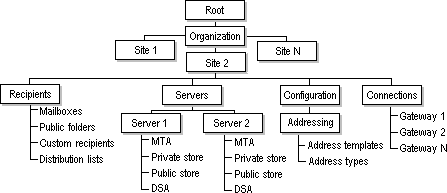
The directory information tree (DIT) represents the userís view of objects within the organization. Although every company has its own unique DIT structure, a typical DIT resembles the one shown in the following diagram.

A typical directory information tree structure
All Microsoft Exchange Server systems have a similar DIT structure at the organization, site, and server levels. However, most DITs differ significantly at the lower levels.
The organization appears at the highest level in the DIT. Only a single instance of the organization is shown because it represents the entire system. Site objects appear on the second level and usually correspond to an organizationís geographic sites. Located below the site objects are a number of containers that group lower-level objects according to their function. For example, the Recipients container holds the mailboxes, public folders, custom recipients, and distribution lists that are used throughout the organization. Custom recipients are users or companies outside the organization, such as vendors or customers.